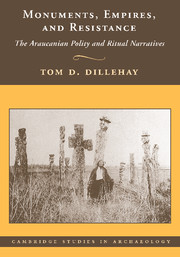Book contents
- Frontmatter
- Contents
- Figures
- Preface
- INTRODUCTION
- PART ONE PROSPECTS AND PATTERNS
- PART TWO ANALYSIS AND INTERPRETATION
- SEVEN CONTACT, FRAGMENTATION, AND RECRUITMENT AND THE REHUEKUEL
- EIGHT RECURSIVENESS, KINSHIP GEOGRAPHIES, AND POLITY
- NINE EPILOGUE
- Appendix One Ethnographic Ritual Narratives at Hualonkokuel and Trentrenkuel
- Appendix Two Radiocarbon Dates and Thermoluminescence Dates
- References Cited
- Index
NINE - EPILOGUE
Published online by Cambridge University Press: 27 July 2009
- Frontmatter
- Contents
- Figures
- Preface
- INTRODUCTION
- PART ONE PROSPECTS AND PATTERNS
- PART TWO ANALYSIS AND INTERPRETATION
- SEVEN CONTACT, FRAGMENTATION, AND RECRUITMENT AND THE REHUEKUEL
- EIGHT RECURSIVENESS, KINSHIP GEOGRAPHIES, AND POLITY
- NINE EPILOGUE
- Appendix One Ethnographic Ritual Narratives at Hualonkokuel and Trentrenkuel
- Appendix Two Radiocarbon Dates and Thermoluminescence Dates
- References Cited
- Index
Summary
By combining different sources of information, I have attempted to locate Araucanian mounds within the broader social history that constituted them and was partly constructed by them. Much of this history is related to culture contact, empire building, resistance, utopic vision, knowledge systems, secular and sacred agency, identity and memory, population movement, compatriotism, and polity formation. It might be that almost all specific forms of economic, social, and cultural organization that are documented for the Araucanians in the sixteenth and seventeenth centuries need to be understood primarily as transformations within a unitary field of population displacement and ethnic polity development. If so, it is necessary to pay closer attention to the interconnections between lineages and other groups, such as ceremonial exchanges, alliances and conflicts, and patterns of recruitment. A working hypothesis has been that patterns of lineage expansion and contraction changed markedly between the late pre-Hispanic and early to middle Hispanic period and that a single dynamic process of resistance to outsiders characterized many of the shifting social structures and residential patterns associated with kuel and rehuekuel as religious and political centers and with the exchange of people and materials.
In an attempt to relocate Araucanian history, a purpose of this book has been to challenge the notion that the southern Araucanians were primarily hunters and gatherers, with some knowledge of agriculture, prior to contact with the Spanish and that as a result of this contact they amalgamated and semicentralized to defend themselves against the intruders.
- Type
- Chapter
- Information
- Monuments, Empires, and ResistanceThe Araucanian Polity and Ritual Narratives, pp. 398 - 410Publisher: Cambridge University PressPrint publication year: 2007



